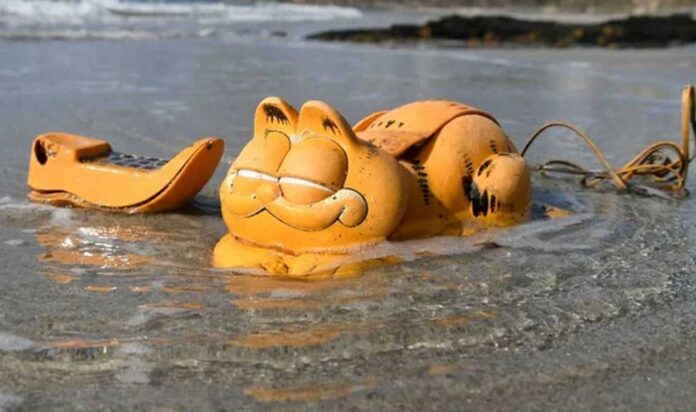If you ever find yourself strolling along the scenic beaches of Brittany, France, don’t be surprised if you catch a glimpse of something… unusual. No, it’s not a rare seashell or a mystical message in a bottle. It’s a smirking orange cat. Not just any cat, mind you, but Garfield himself. Or at least, part of him—perhaps a coiled phone cord, a number pad, or his chubby, judgmental face—courtesy of the strangest environmental mystery ever to hit these shores.
Welcome to the world of the Garfield phone invasion, where for the last 30-odd years, fragments of bright orange Garfield novelty phones have been washing up along the coastline. That’s right—since the 1980s, beachcombers and environmentalists alike have been greeted by the grinning, lasagna-loving feline in the form of plastic phone parts scattered across the sandy shores of the Iroise coast.
This isn’t just a random case of washed-up trash—this is Garfield we’re talking about! For years, it was as if he had a grudge against the coastline, leaving behind his sarcastic smirk wherever the tide went. No matter how many beach cleanup teams cleared the feline debris, more Garfield bits kept appearing, making people wonder if he was immortal—or just a really persistent prankster.
But let’s back up a bit. This saga began in the 1980s, during the height of Garfield’s fame, when novelty phones featuring the rotund orange cat were all the rage. Picture this: Garfield, snoozing lazily, only opening his eyes when you lifted the phone receiver. It’s quirky, it’s fun, and it’s now responsible for one of the most bizarre cases of ocean pollution in recent memory.
For years, the locals speculated about where the phones were coming from. Was it some kind of cosmic joke? Or perhaps a lost shipping container, sitting at the bottom of the ocean, releasing its feline cargo one piece at a time like a slow-motion magic trick?
Cue Claire Simonin-Le Meur, president of the environmental group Ar Viltansoù, who, along with her fellow activists, had been tirelessly collecting Garfield’s rogue body parts (plastic ones, to be clear) while pondering the mystery. Beach cleaners could only shake their heads in disbelief as Garfield continued to haunt them. The big question loomed: Where were all these cat phones coming from?
The answer arrived in the form of a local farmer named René Morvan, who, like a real-life Scooby-Doo, solved the case in the most unexpected way. Turns out, he’d known about the secret of the Garfield phones for decades. Back in the mid-80s, after a particularly fierce storm, Morvan and his brother had stumbled upon the source: a shipping container, stuffed to the brim with—you guessed it—Garfield phones, wedged deep in a cave on the coast.
The problem? The cave, like a loyal guardian of the mysterious container, was only accessible at low tide, making it nearly impossible to get to most of the time. But that didn’t stop the intrepid environmentalists. Armed with this new knowledge, they ventured into the cave, hopeful that they would find the still-intact container, overflowing with pristine Garfield phones that could finally be prevented from polluting the ocean.
Alas, they were too late. When they finally reached the cave, what they found was a rusty, dilapidated container—and it was empty. The sea, in its slow but persistent way, had already done its job, scattering hundreds (if not thousands) of Garfield phones across the ocean and onto the beaches over the course of 30 years.
Talk about a plot twist! The cat was out of the bag—or in this case, the phone was out of the container—and it had been for a long time.
But while the mystery of the sea-faring Garfield phones may be solved, the environmental concerns they highlight are far from over. These phones are a symbol of the larger issue of plastic pollution plaguing our oceans. Over 30 years later, the phone fragments remain largely intact, showing just how durable (and dangerous) plastic can be. Marine animals are at risk of ingesting or becoming entangled in plastic debris, and even as the larger pieces break down, they form microplastics that enter the food chain—right up to humans.
So while the tale of the Garfield phones may seem quirky and fun, it’s a reminder that the consequences of pollution are long-lasting and far-reaching. The volunteers from Ar Viltansoù continue their efforts to clean up the coastline, and as long as there are Garfield phones lurking out there in the ocean, the battle isn’t quite over.
But hey, at least now we know—somewhere out there, in the depths of the sea, a lost generation of novelty phones is still making waves. Quite literally.

